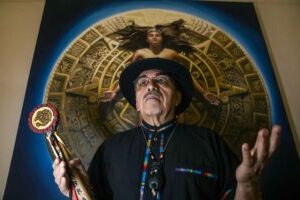From the Los Angeles Times: “[Compton native Jerry] Tello and fellow therapists and community health practitioners, including a psychiatrist, began meeting to explore traditional Indigenous methods of helping the Chicano and Latino community; the group called itself Calmecac.
‘We began exploring that, within our own culture, we had volumes that were written about healing, constructs, methodologies, philosophies, remedies and traditions that we didn’t know about that our grandmothers used but that were not validated,’ he said.
This research, his college background, his clinical work and his experience of the Chicano and civil rights movements in Los Angeles pushed him to ‘explore effective ways [for] really healing, not just treating, not just intervening, not just medicating and diagnosing but truly healing our people’ . . .
Regarding mental health, what does ‘healing the whole person’ mean?
There is a word in my Indigenous Nahuatl language, Tloque Nahuaque, which, loosely translated, means interconnected sacredness. In Indigenous thought, our sense of wholeness or well-being is a sense of us being physically, mentally, emotionally and spiritually balanced and harmoniously connected to ourselves and all our relations.
. . . In our traditional way, [healing practitioners] don’t separate the physical from the emotional, mental and spiritual. It’s all interconnected. So, from a healer’s point of view, we begin to look at all relationships and influences in your life… It may not be just in your present life but the spirit of what you carry from your life journey … what we refer to now as generational trauma. And from the spiritual, we talk about your meaning in life — how worthwhile do you feel as a man, woman or teenager? What’s your role?
. . . From an Indigenous point of view everything is a teacher, a spirit, if you will. So we ask [about] what the ‘so-called’ depression or anxiety tells us and where is it coming from. In an Indigenous point of view, those ‘spirits’ can get attached to you and can become that overwhelming feeling. It also may be due to the ‘mal’ bad energy that someone [has] projected on you and things that people have said about you that you are believing.
That may seem strange or mystical, but all of us have at one time or another been in a good mood, walked into someone’s office who is in a bad mood and then walked out feeling all messed up… It may necessitate a limpia —cleansing or the clearing of those burdensome thoughts or energy . . .
How do you apply your clinical background in your traditional healing work?
We must recognize that this society is sick. The pandemic showed this. The racism, colonization, injustice and system inequities that exist in communities produce stress, trauma [and] fear and literally kill people. So, although individual intervention and treatment is important, healing at the community and societal level is imperative . . .
How could our mental health system help more people?
Once you put a diagnosis on someone, it’s almost like you’re putting a spell on them. [If someone says,] ‘[You have] attention deficit,’ [you think]: ‘Oh, shoot, that’s what I am.’ No, you’re not. That’s your woundedness, because you’re much more than that. Western science will label people and categorize them based on their woundedness. In [our] traditional medicine, we see their wholeness.
Maybe one of your wounds or cargas (your burden, or what you’re carrying) is alcohol. The alcohol can take over your spirit and we [as healers] understand that. In reference to alcohol … it’s no coincidence that they call alcohol a spirit. We know the substance or spirit of alcohol changes you. And the more it becomes part of who you are and what you do, that ‘spirit’ can begin controlling you.
It is important in the most serious cases to recognize that … you have invited that spirit to take over your life. Many people have ‘lost touch’ with who they really are, but even in those cases, in order for them to truly heal, we must ‘call their spirits back’ to the sacredness of who they really are and at the same time acknowledge the spirit of the substance that continues to challenge them everyday.
Unfortunately, Western treatment reverses the order and makes the disease their identity, as if they are nothing without the disease. A central part of Indigenous thought and healing is that the Creator and our ancestors are always present and our sacredness is always in us just waiting to be healed, blessed and released to do its sacred purpose.”

***
Back to Around the Web











